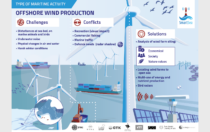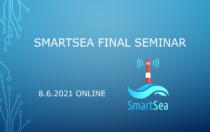Offshore wind energy potential in the Gulf of Bothnia

Need for offshore wind energy
Finland’s national target of increasing the share of renewables above 50% of total energy production in the 2020s will only be realized by large-scale investments in sea areas. This development is also strongly supported by the Europe Union’s Blue Growth strategy. The Gulf of Bothnia features a potential for large capacity wind farms because of relatively high and constant wind velocities. In addition, the shallow coastal areas enable simple foundation and grid connection. However, in the Gulf of Bothnia, the sea freezes annually introducing a challenging operational environment for marine structures and operations, as sea ice loads introduce the most significant uncertainties in the structural design of wind power units.
Need for MSP-tools
Reliable and cost-effective solutions are essential from the viewpoint of manufacturing, site-installation, operation and maintenance. Therefore, mutual understanding of environmental conditions and their actions on structures is required. Site-selection of wind farms from the perspective of technological, economic and environmental impact is a key part of marine spatial planning (MSP). Therefore, we are developing an ice load portal to simplify and speed-up the preliminary design phase of offshore wind farms. The ice load portal is a modular script-based design tool, which will be freely available via an internet browser. This portal will combine the site-specific data of environmental conditions (ice, wind, water depth and seabed conditions), the structural model for the offshore wind turbine and the environmental loads into a single tool. The ice load portal can be utilized for feasibility studies to find an optimal solution for the siting of a wind park and the corresponding structural solutions.
The world’s first offshore wind farm in harsh ice conditions
Modern wind turbine technology enables large-scale renewable energy production in sea areas. As an example, the world’s first offshore wind farm in harsh ice conditions, Tahkoluoto, will be built in 2017 in the Gulf of Bothnia outside Pori at the West coast of Finland (http://hyotytuuli.fi/en/tuulipuistot/tahkoluoto-offshore-wind-power-project/). Tahkoluoto offshore wind park has 10 turbines, each of them 4 MW. The overall nominal power is therefore 40 MW.
Scenario for large-scale offshore wind power
As a scenario, we scale-up the wind power production and consider a wind park area of 20 km times 20 km with 7 MW turbines. By presuming 1 km distance between the turbines we could fill the area with 400 turbines. The efficiency in the wind energy production depends naturally on the wind conditions. By considering a reasonable efficiency based on annual wind statistics, the annual wind energy production with above mentioned specifications corresponds to a nuclear power unit (1.2 GW). The required area (~400 m2) for this energy production is slightly larger than Hailuoto Island, as illustrated in Figure 1.
Jaakko Heinonen, Toni Hekkala, Juha Kurkela
Articles

Pohjanlahti merituulienergian tuotantoalueena
Konteksti Merituulienergian laajamittainen rakentaminen on keskeinen askel Suomen tavoitetta hiilivapaaksi yhteiskunnaksi. Suomen merialueista erityisesti Pohjanlahti tarjoaa hyvät olosuhteet energian tuotannolle,

Scientific Articles published in SmartSea
One of the products of the SmartSea are the various scientific articles published by our partners during the project. The

SmartSea Infographics
Offshore wind production, Aquaculture, Fisheries, Blue Well being, recreation and tourism have been key areas of the SmartSea project. We

SmartSea Final Seminar/Loppuseminaari 8.6.2021
SmartSea will hold a Final Seminar on the results of the project, and a discussion with stakeholders and affiliates on
